Every Cricket World Cup ranked from worst to best
This year’s World Cup will be the 12th edition of the global event. The previous 11 have served up drama, controversy, heroes and plenty of villains. But which was the best, and why?
Cricket
Don't miss out on the headlines from Cricket. Followed categories will be added to My News.
- Murder of a cricket coach that never was
- Most bizarre innings in World Cup history
- Rhodes: the photo that changed my life
- Leverock and the catch that shook the world
The 12th edition of the Cricket World Cup gets underway this week promising to be both an open and high-scoring affair.
Whether we will look back on it as fondly as previous classics or lament reality failing to live up to expectations we will only know after the July 14 final.
In the meantime, below is a reminder of what this event has to live up to, or live down (our cricket brains trust ordering the 11 World Cups from the worst to best):
No.11: 2007
A tournament under a long shadow of the death of Pakistan coach Bob Woolmer and the farcical investigation into a murder that never was.
And, despite a great Australian team picking up the silverware, an event low on overall quality elsewhere, sucking drama from the contest across a bloated 56 days, that was shambolic throughout and ended with a whimper, confusion and near darkness in an unsatisfactory final.
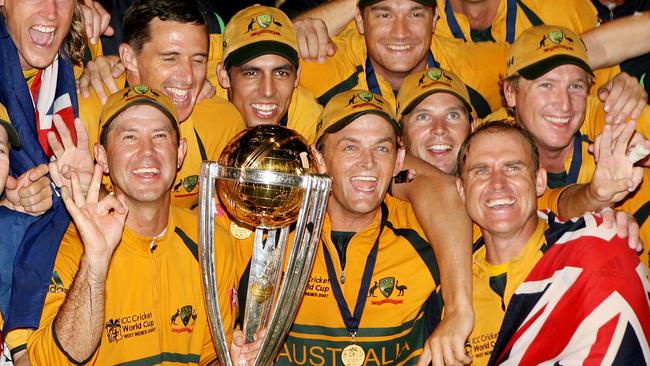
A mere 20 years after picking up their first title, Australia took home a fourth in much more comfortable circumstances than they did in 1987.
The Aussies were at the peak of their powers. A golden generation supplemented with some rising stars.
On the postage stamp-sized grounds in the Caribbean, there were runs galore on offer, and with a line-up featuring Gilchrist, Hayden, Ponting, Clarke and Hussey, Australia only once failed to reach 300 from six attempts when batting first.
GLENN MAXWELL: Aussies’ star turn primed for another big show
JOS BUTTLER: England’s power-hitter playing in a different gear
RASHID KHAN: The pain inspiring Afghan leggie to World Cup glory
Glenn McGrath, Shaun Tait, Brad Hogg and Nathan Bracken took 76 wickets between them, with veteran McGrath ending his ODI career on a high with 26 scalps.
The Aussies faced Sri Lanka in a decider that was initially delayed by rain, then briefly lit up by vintage Gilchrist century before descending into utter chaos in the gloom of an overcast Bridgetown evening.

Australia thought they had won the match when the umpires suspended play for bad light with Sri Lanka off the pace. The initial ruling was for the final three overs to be bowled the following day
But they instead agreed to return that evening, in almost total darkness, to get the game finished.
Best innings: The final as a whole may have been something of a letdown, with the final confused overs played out in near total darkness. But Adam Gilchrist’s 104-ball 149 at least put some polish on proceedings and underlined his claim to be one of the greatest ODI batsmen of his or any other generation.
Best bowling: Glenn McGrath followed by daylight. The Australian legend, approaching his 37th birthday, took a tournament-record 26 wickets. After taking three wickets in four consecutive matches (3/31 v West Indies, 3/16 v Bangladesh, 3/62 v England, 3/17 v Ireland), his standout performance was in the semi-final against South Africa, his 3/18 from eight overs as economical as it was destructive.
Best game: In a tournament low on memorable contests, few in Bangladesh will have trouble summoning up the details of their historic win over India. India captain Rahul Dravid chose to bat first on a pitch that warned against it, but thereafter Bangladesh’s youthful set of bowlers performed beyond expectation. Mashrafe Mortaza’s consistency saw him take four wickets for just 48 runs before the flair of a couple of left-hand spinners completed the job and restricted India to 191. In the chase Tamim Iqbal, in just his fifth ODI, blazed a 53-ball half century, before Saqibul Hasan and Mushfiqur Rahim put on an 84-run stand that belied their tender years (the three key batsmen had an average age under 19). India failed to reach the knockout stages as a consequence. A major scalp for Bangladesh on their World Cup debut.
If this World Cup was a TV show it would be … GAME OF THRONES.
This was a tournament that promised plenty — and then fell flat on its face when the final rolled around. Australia won in near darkness in scenes remeniscent of the Battle of Winterfell. And the farcical ending simply left most fans deflated.
—
No.10: 2011
A joyful occasion for the billion plus Indians who had willed for the outcome that duly arrived, with Sachin Tendulkar’s legacy burnished still further. And for the fearlessness and talent that Ireland brought to the party — something that will be sorely missed this year.
But also a tournament that took time to get going, stretched over what felt like too long and produced a series of one-sided contests, chiefly involving Kenya, Canada, Zimbabwe and Netherlands, the two elements combining to suck momentum and drama out of the early stages in particular.
In fact only England’s traditional ineptitude on this stage injected drama in to the group stages: their narrow, laboured win over Netherlands presaging a loss to Bangladesh in Chittagong that gave the co-hosts their own moment of delirious euphoria.
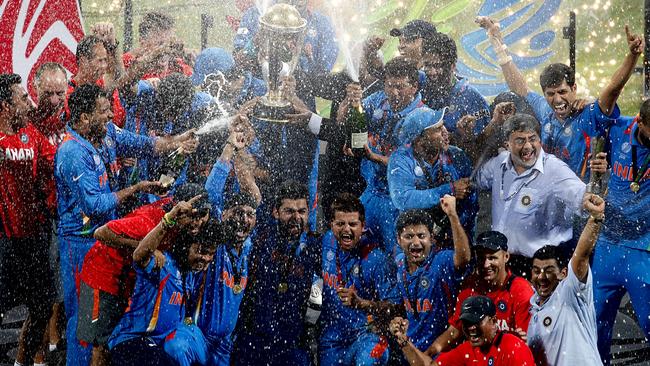
An Australia squad featuring Ricky Ponting, Michael Clarke and Shane Watson lost to Pakistan in the group stage and were dumped out of the tournament in the first knock-out round against the eventual champions, the only occasion they have failed to at least reach the final in the last quarter-century.
In many ways the whole tournament was about India underlining their rise to powerhouse status in the world game. The stands were full and the noise deafening — other than when Sachin was dismissed, of course.
MS Dhoni’s crunching six to win the final over Sri Lanka summed up the occasion neatly in one stroke, an almost pre-ordained success that sparked scenes of wild celebrations unrivalled at any previous or subsequent final.
Best innings: Sachin Tendulkar and Virender Sehwag put on 142 runs for the first wicket against South Africa in Nagpur in just 17 overs, with Dale Steyn and Morne Morkle made to look like park players. Utterly breathtaking. And yet, it’s impossible to look beyond Kevin O’Brien’s 113 against England in Bangalore (though Ryan ten Doeschate’s 119 in a losing cause against the same opponents deserves an honourable mention, too). Coming in when Ireland were 4-106 (and 5-111 soon after), O’Brien raised three figures off just 50 balls for the quickest century in the competition’s history. As unexpected as it was sensational.
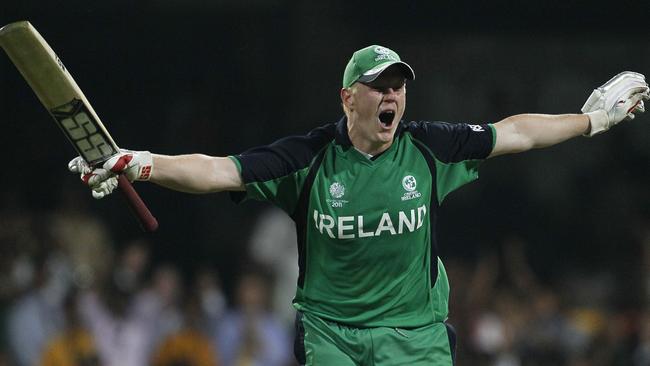
Best bowling: Shahid Afridi’s 4-34 against Sri Lanka was a lesson in the use of variations in one-day cricket to unsettle world class batsmen. While, in a disappointing tournament for Australia, Brett Lee did manage to produce one of the best turns with the ball. Defending a modest 176 against Pakistan, Lee took to the task almost alone. Having taken two wickets in his first spell Ponting returned to him with the match slipping away. Successive ball wickets of Younis Khan and Misbah-ul-Haq gave hope of maintaining Australia’s 34-game unbeaten World Cup run, but it wasn’t to be.
Best game: England and India played out a match in which both had a chance to win and both did their best to lose but ultimately ended in a tie, both sides putting 334 on the board in Bangalore. Sachin Tendulkar notched his 98th century and Andrew Strauss scored 158. In a tournament low on drama this was the most compelling fixture of the early stages.
If this World Cup was a TV show it would be … FRIENDS
An undeniably popular show. But was it really any good? Certainly, it’s not a patch on Seinfeld (but more on that later). Needless to say, lots and lots and lots of people watched it though.
—
No.9: 1979
After the novelty of the first World Cup there were fears of an ‘after the Lord’s major’s show’ sentiment affecting this one. The English weather — which had so graciously behaved itself in 75 — did its best to aggravate this. And the quality across the tournament was not quite to the 75 standard even if the imperious West Indies maintained their dominance with both bat and ball.

It was definitely one to forget for Australia, who sent a largely unknown and entirely underwhelming side to England with their best players still contracted to World Series Cricket.
New Zealand’s battalion of medium pace all-rounders made them a difficult prospect to face and cruised through to face England in the semi-finals, where they fell nine runs short in the face of solid innings from Mike Brearley and Graham Gooch.
West Indies made hard work of overcoming Pakistan, for whom Majid Khan and Zaheer Abbas put on a fine partnership of 166 before Viv Richards restored order with three wickets at less than 20 apiece.
England were a tough Test side at the time but their inability to score quickly — Geoff Boycott shares little in comparison with Jos Buttler other than a passport — cost them and the visitors defended their title.
INDIA: Kohli a better chaser than lemon after tequila
ENGLAND: Great expectations, but danger lurks
SOUTH AFRICA: Chokes ‘a dark mist that hangs over us’
BANGLADESH: Unheralded Tigers ready to roar
Best innings: Richards may have added the final flourish at Lord’s with a breezy six to end West Indies’ innings, but it was the blistering scoring of Collis King that did most to seal victory in the final. Just 66 balls were needed for his quick fire 86, which included 10 fours and three sixes. Cue more delirious scenes from the Caribbean diaspora in London.
Best bowling: Despite the brutal elegance of Richards and King, England were close to giving it a shake in their chase in the final. That was until Joel Garner came to the party, the towering quick pulverised England with figures of 10-0-38-5, as the hosts crashed from 2-183 to 194 all out.

Best game: The final once again showed West Indies at their destructive best, but it came as little surprise to anyone who had seen their group game against a decent New Zealand side who ran them closer than the English could. Gordon Greenidge and Clive Lloyd swung the willow to post 244 from their 60 overs. Richard Hadlee, Mark Burgess and Jeremy Coney offered spirited response. Which served merely as an invitation for the West Indies quicks to raise their game, a match thus demonstrating all that was good about the dominant side of the era.
If this World Cup was a TV show it would be … FAMILY GUY
Still a great team doing great things, but after the historic nature of 1975 this just felt like a cheap rip-off of a trailblazing show.
—
No.8: 2015
Australia won their fifth title. Bangladesh and New Zealand hit their highest peaks. And England hit pretty close to rock bottom.
There was much to like about the most recent of World Cups, which lifted the tempo of run rates and was the first tournament to really show the impact of Twenty20 cricket on fast scoring.
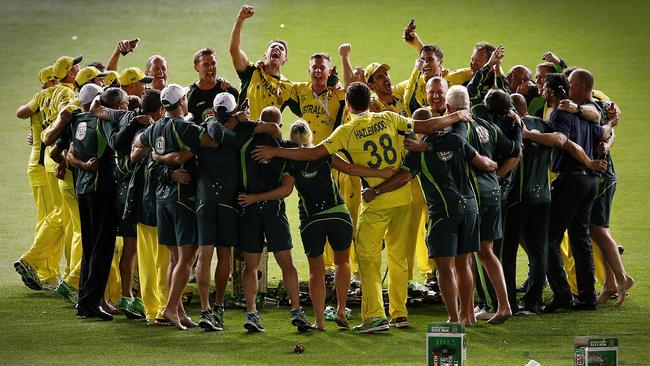
But despite the event being dominated by the bat, Mitchell Starc confirmed his status as the world’s best white-ball bowler with a stupendous tournament.
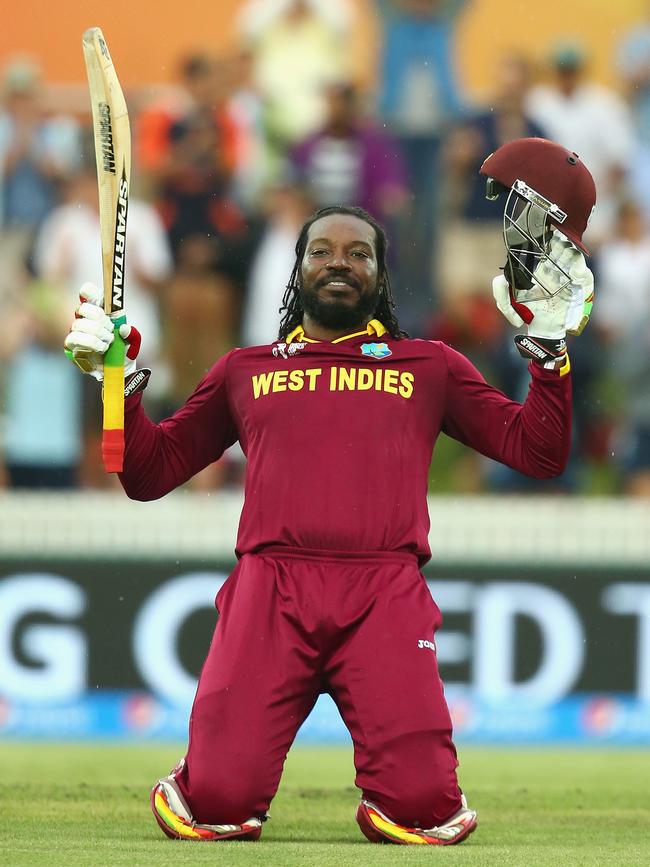
And while for much of the lengthy tournament it felt like a procession towards a likely Australian victory, it deserves to be considered for greatness purely because of some of the all-time classics it involved.
Were it not for New Zealand’s truly stunning semi-final escape against South Africa — and we’ll have more on that in a moment — then the Black Caps’ stunning last-ditch win over Australia in the group stages would mount a serious case for ‘match of the tournament’ status.
There were fireworks throughout, such as when Wahab Riaz went toe-to-toe with Shane Watson in one of the most explosive spells recorded in World Cup cricket — but also the utter carnage of Chris Gayle blasting the first ever World Cup double century, only to have his effort bested by Martin Guptill a couple of weeks later.
Gayle etched his named into the record books with his outrageous hitting at Manuka Oval, when he sent the Canberra locals scrambling for safety after reaching his hundred from 105 balls — hitting 16 sixes as he added a mind-boggling 372 for the second wicket with Marlon Samuels.
Oh, and then there was Bangladesh’s utterly absurd upset of England — which put paid to the perennial underachievers’ tournament, and ultimately led to the demise of Peter Moores as coach.
It was that sort of World Cup.
Best innings: Gayle created history by becoming the first World Cup batsman to hit a double century. But, with respect, it was against Zimbabwe. And Martin Guptill topped his effort less than a month later, with a frankly ridiculous 237 from 163 deliveries.
Best bowling: Mitchell Starc running riot for 6-28 against New Zealand, and damn near defending Australia’s paltry 151 on his own, was fast bowling at its best: full, fast and fearsome. It prompted Glenn Maxwell to mimic a ‘choke’ to the Eden Park faithful — which didn’t turn out too well, with Kane Williamson icing a one-wicket win with a straight six. But Starc’s spell was unforgettable.
NEW ZEALAND: Dark horses or genuine thoroughbreds?
PAKISTAN: Chaos as ever, but beware the ‘wounded tigers’
AFGHANISTAN: The former minnows now thinking big
SRI LANKA: Factions, frictions and a failure foretold
Best game: Match of the tournament? The semi-final between New Zealand and South Africa goes straight into contention for best World Cup match ever. The poor Proteas were in control for much of the rain-affected match, set New Zealand 281 to win from 43 overs, and had one foot in the final when Grant Elliott became the unlikeliest of heroes. Needing five runs from two deliveries — and facing the might of Dale Steyn — Elliott (who finished on 84 from 73) slapped a six over mid-on and sent the Black Caps into their first ever final. It was wild.
If this World Cup was a TV show it would be … NEIGHBOURS
This could be best summed up as Australia’s World Cup. They hosted it. They won it. They celebrated with 1000 beers each. But, much like Russell Crowe’s four-episode Neighbours cameo back in the 80s, the Kiwis almost stole the show.
—
No.7 2003
Australia’s perfect tournament — which could’ve gone so madly, madly wrong.
It’s easy to forget how rocky Australia’s road to glory was when you look back at the flawless record — 11 wins from 11 attempts — and the utterly dominant thrashing of India in the final which secured a third World Cup title.

But what makes this arguably Australia’s greatest Cup triumph, built around its best ever one-day team, was the hurdles it overcame.
Before a ball had been bowled, their campaign was derailed by the loss of superstar spinner Shane Warne in extraordinary circumstances just two days before their first match.
Despite an all-time great batting line-up, Australia were rocked by top order collapses against Pakistan (4-86), New Zealand (7-84) and England (4-48, 8-135) but still managed to eke out victories.
This was a special team, boasting Gilchrist, Hayden and Ponting at the top of the order, Bevan and Symonds holding things together in the middle, and a bowling attack that boasted McGrath, Lee and Bichel.
Who even needed Shane Warne?
For the second World Cup in a row, the host nation bowed out early — though South Africa’s premature exit in 2003, as one of the pre-tournament favourites, was even more shocking than England’s demise in 1999.
The tournament was haunted by the political minefield that was Robert Mugabe’s Zimbabwe — with stars Andy Flower and Henry Olonga donning black armbands to ‘mourn the death of democracy’ in the nation, while England effectively gave up a Super Six spot after forfeiting its match in Zimbabwe.
Australia’s (well, Canada’s…) John Davison also blasted the quickest World Cup hundred from just 67 balls. And Kenya made the Super Sixes stage (what?!).
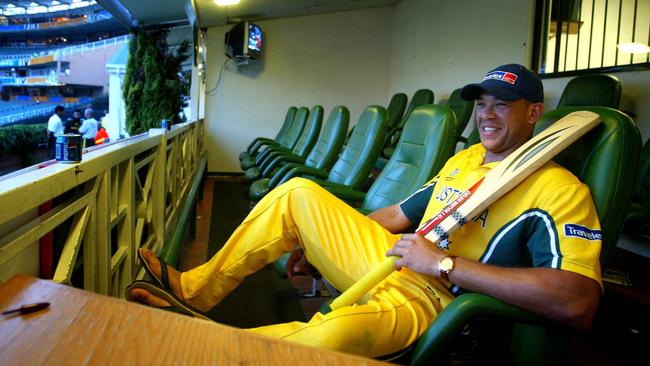
But nothing could stop Australia, who gathered steam as the tournament went on and sealed things with a near perfect final — in which Ricky Ponting’s unbeaten 140 was the centrepiece.
Best innings: Ricky Ponting’s 140 was the epitome of delivering on the biggest stage. But Andrew Symonds unbeaten, back-against-the-wall 143 in Australia’s opener against Pakistan set the tone for the tournament, and came with Australia firmly on the ropes. It was also a breakthrough moment in the big fella’s career — and he would go on to become one of the nation’s finest white-ball cricketers.
Best bowling: Quicks feasted on the fast wickets and favourable conditions in South Africa. Glenn McGrath’s 7-15 against Namibia was the definition of a mismatch while Andy Bichel’s 7-20 was simply superb. Shane Bond (6-23) tore Australia to shreds, as Chaminda Vaas did to Bangladesh with his 6-25. But we’ll give the honour to Ashish Nehra bowling ten overs straight to rip through England to the tune of 6-23 and seal a Super Six spot for India. It was the high point of a career.
Best game: Australia fighting back from 8-138 to successfully chase down England’s modest target of 205, with Michael Bevan doing Michael Bevan things — and Andy Bichel being the wholehearted winner that he is — to pull off a two-wicket win with two balls to spare? That’s as good as it gets.
If this World Cup was a TV show it would be … THE WIRE
With Warney wiped out on the eve of the tournament, this World Cup was always going to have an early pharmaceutical-themed plot line. But Australia pulled off a perfect tournament, with no narrative missteps from first to last. And Ricky Ponting delivering a flawless ending.
—
No.6: 1983
The West Indies juggernaut was brought to a screaming halt by the most unlikely of candidates.
Led by the redoubtable Kapil Dev and boosted by some excellent contributions from Mohinder Armanath, Roger Binny, Madan Lal and Ravi Shastri, India ended the mighty Windies’ eight-year reign in a nervy final.
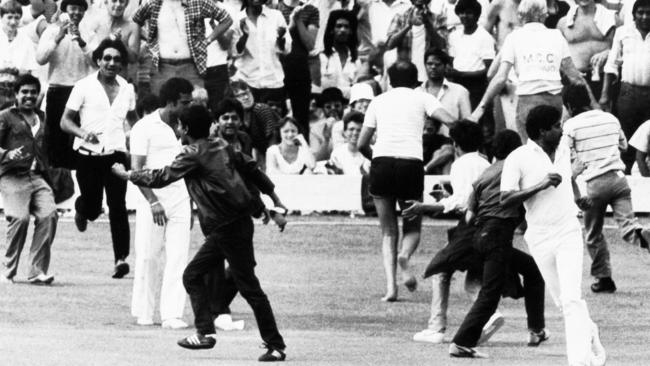
Chastened by a preliminary round defeat to India two weeks previously, the Windies, on a Lord’s green top suited to their fearsome foursome of Andy Roberts, Joel Garner, Malcolm Marshall and Michael Holding, knocked over India for 183.
But despite a rapid knock from the great Viv Richards, the much-vaunted Windies batting line-up failed to cope with the seaming ball and fell 43 runs short.
Australia produced arguably their worst display in Cup history, considering the talent at their disposal, bowing out after the group stages.
Their search for a maiden title couldn’t have got off to a worse start when future Ashes protagonist Duncan Fletcher inspired one of the biggest upsets of all-time.
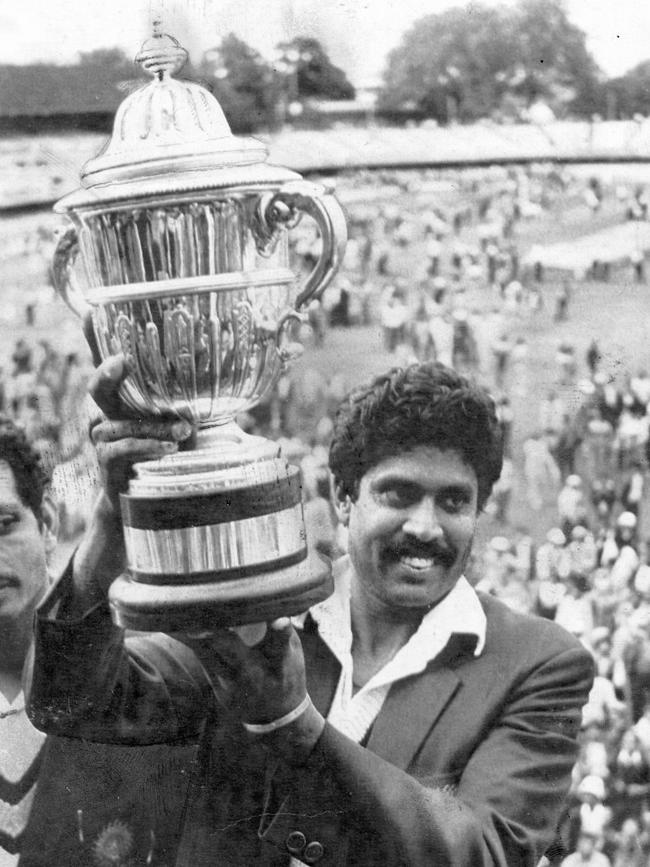
Fletcher scored an unbeaten 69 and later took four wickets as Zimbabwe pulled off a 13-run victory at Trent Bridge.
Ignominy for Australia, but the start of India’s love affair with short-form cricket from which a line can be drawn directly to the modern day IPL.
Best innings: India’s shock win may never have come about but for a stunning contribution from Kapil Dev against a troublesome Zimbabwe. Five down with just 127 runs on the board strode out to the middle and struck an unbeaten 175 off just 138 balls. India needed the runs he provided, Zimbabwe Kevin Curran’s 93-ball 73 taking them close but ultimately 31 runs short.
Best bowling: Sri Lanka were not a strong unit in this World Cup and a variety of bowlers burnished their records against them. English off-spinner Vic Marks used local knowledge of the Taunton pitch to rip through their middle order for figures of five for 39, to this day a World Cup record for an Englishman. While Richard Hadlee’s own five-for, giving up just 25 runs, helped peg back Sri Lanka from 3-144 to 206 all out and give New Zealand a comfortable victory.
Best game: Even at the semi-final stage India were expected to fall apart when it mattered. But at Old Trafford, despite Roger Binny removing both England openers, the hosts were travelling well. Until Yashpal Sharma ushered in an England collapse their fans are now well used to seeing. All out for 213, England were quickly punished by a confident Indian side, led by allrounder Mohinder Amarnath’s breezy 46.
If this World Cup was a TV show it would be … LOST
Widely regarded as one of the benchmark World Cups, with great drama throughout … and what about that twist at the end!
—
No.5: 1992
It wasn’t just the introduction of those now iconic World Cup kits that gives the 1992 edition a sense of being the first modern World Cup. The TV coverage was more extensive and night matches brought a sense of spectacle we now take for granted.
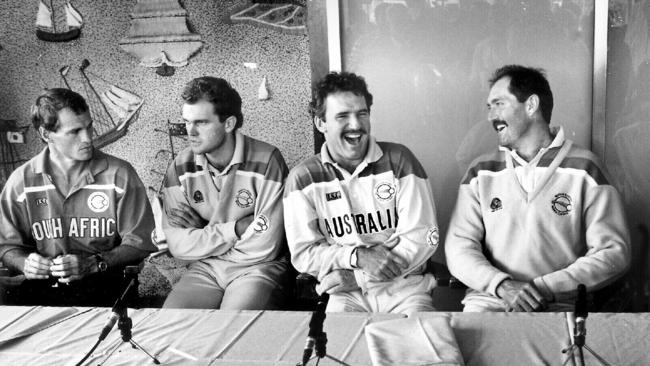
The rain of late summer in Australia and New Zealand had striven to put a dampener on proceedings. South Africa’s infamous semi-final with England descended in to farce with the confusing application of the soon-to-be-abandoned rain rule when a challenging 22 from 13 balls to win became 21 from a single delivery.
But the fact that the Proteas were there to fall foul of its vagaries was reason in itself to consider this World Cup a success.
It hadn’t been guaranteed, with the event expanded from eight to nine teams at the last minute. Apartheid was still in its final death throws. But justified optimism of its final demise and a public vote to confirm moves to that end allowed the South Africans to take part.
As entertaining a tournament as it was, it was one to forget for Australia, who never recovered from opening defeats to New Zealand and South Africa. The co-hosts were the revelation of the competition, losing a single game to top the sole group.
That loss had been to Pakistan, who snuck through despite losing three matches and set for another when bowled out for 74 before the rains came against England in Adelaide. The point they got for that wash out pushed them ahead of Australia.
Pakistan had been out of form and disjointed coming in to the tournament. They didn’t field the same 11 in consecutive games. But they took their chance when presented. Responding to Imran Khan’s call to play like ‘cornered tigers’ (he even wore a tiger T-shirt to the toss for the final), they first overcame New Zealand on home soil then countered a strong England at the MCG to seal a memorable and unexpected title.
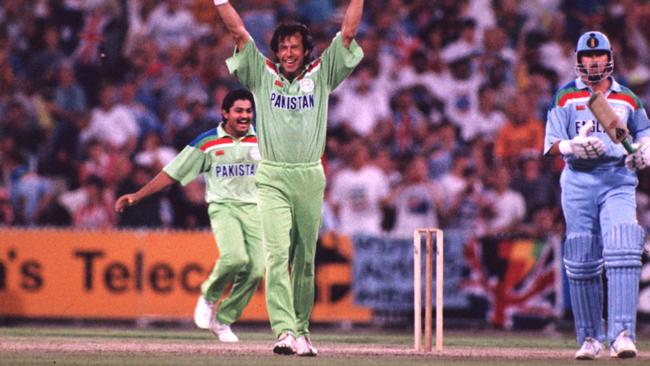
Best innings: Take your pick of two from Inzamam-ul-Haq, whose 42 in the final against England set the platform and, possibly more importantly, who struck 60 from 37 balls against the Kiwis in the semi-final which turned a dire position in to a winning one.
Best bowling: Eddo Brandes’ match-winning spell that helped Zimbabwe to get the better of England — four wickets claimed off his 10 overs for just 21 runs — is worthy of note. But for sheer impact Wasim Akram’s second spell in the final, in which he dismissed the well set Allan Lamb and Chris Lewis in consecutive deliveries, turned the match decisively in Pakistan’s favour.
Best game: In the first semi-final, between New Zealand and Pakistan, 40,000 fans at Eden park were treated to a thriller, of not the result most there wanted. First Martin Crowe — the batsman of the tournament — had smashed 91 off 83 deliveries to see the Kiwis to 7-262. Before Inzamam-ul-Haq counter punched with 60 off just 37 balls to turn the match on its head and secure a four-wicket win.
If this World Cup was a TV show it would be … GLEE
Bright, brash, noisy and a spectacle for the whole family. With a sprinkling of positive messages about persevering despite setbacks and why inclusivity is a good thing.
—
No.4: 1987
It was a time when Australian cricket was at one of its lowest ebbs.
Yet with Allan Border leading from the front and host of young guns — Steve Waugh, Geoff Marsh, David Boon and Craig McDermott among the most notable — and Bob Simpson at the coaching helm, the Aussies pulled themselves off the floor to produce a tournament of immense quality and set a platform for future Aussie dominance.
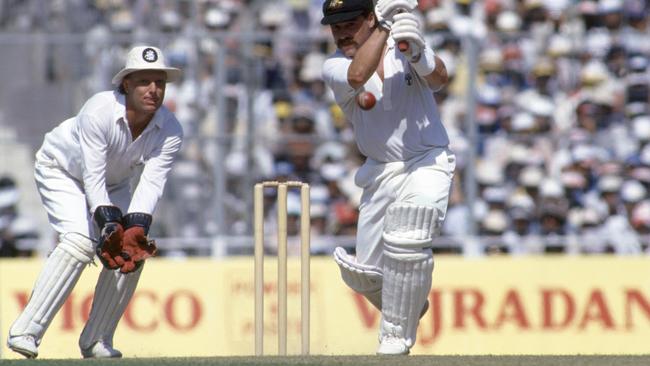
But it all could have come crashing down in the very first game against India if not for steely team manager Allan Crompton.
A Dean Jones six was only credited as a boundary until Crompton marched off to the match referee to get it rectified. Indian captain Kapil Dev agree to the change, and it ensured the target would be 271.
It made all the difference as Australia won by a mere one run following an inspired performance from Craig McDermott.
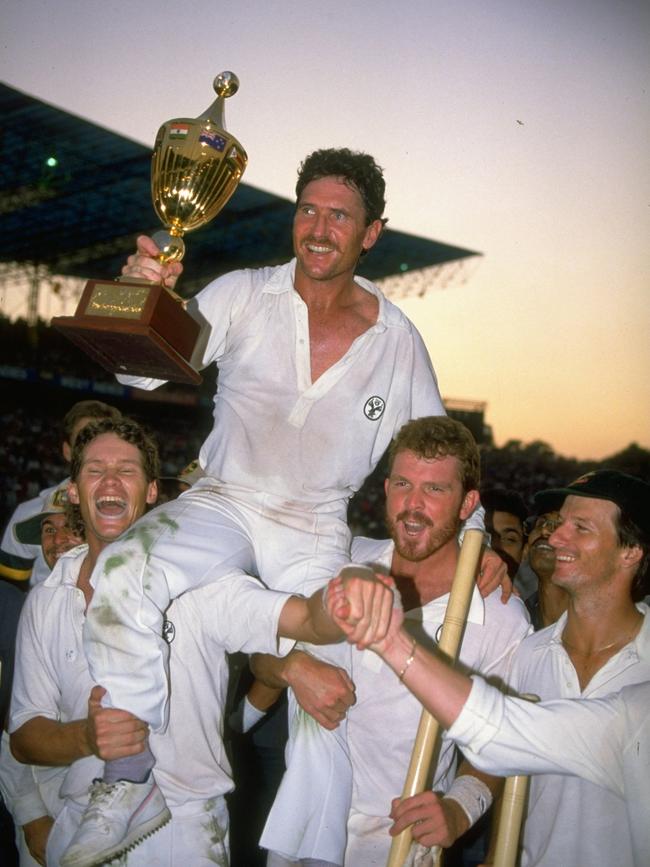
The final against England remains the only time Australia and the Poms have played a game of substance at the tournament to this very day.
And in truth, England played right into Australia’s hands, throwing away a potential winning position with some reckless batting. Who can forget Mike Gatting’s ill-advised reverse sweep or Allan Lamb’s inglorious swipe across his stumps with the victory target in sight?
The tournament was also notable for the end of an era as West Indies — even with captain Viv Richards in imperious form — failed to make it out of the group stage.
Best innings: He was the original Master Blaster — and Viv Richards put on a show against a modest Sri Lankan attack, carving out an enormous 181 from 125 balls. In 1987, it was a simply staggering strike rate... and that’s before you consider the final 81 runs came from a mere 27 balls.
Best bowling: As tempting as it is to throw this award to Steve Waugh for his supreme death bowling against both India (defending six runs in the final over) and New Zealand (defending seven), it’s impossible to ignore Chetan Sharma’s historic hat-trick against the Black Caps. In knocking over Ken Rutherford, Ian Smith and Ewan Chatfield, Sharma picked up the first ever hat-trick in a World Cup game — and set up India’s victory.
Best game: Australia’s one-run victory over India was the turning point for Border’s band of brothers. “That was a pivotal moment,” says Allan Border. “If we lost, who knows? We’d been used to losing. To win, and the way we won, that gels the group an feeds the belief. We’d beaten one of the favourites playing at home.”
If this World Cup was a TV show it would be … THE OFFICE (UK Version)
It would soon be followed by the Office (US version) aka the Aussie team after AB, which enjoyed considerably more success — but real fans have fond memories of the gritty nature of the original.
—
No.3: 1996
This might not have been a World Cup for the cricket purists, but it was sure as hell one for the average punter who needed a bit of excitement in their lives.
And there are many reasons why it should be your favourite World Cup — not least of all because it should be viewed historically as one which made a considerable impact on the way one-day cricket was played.
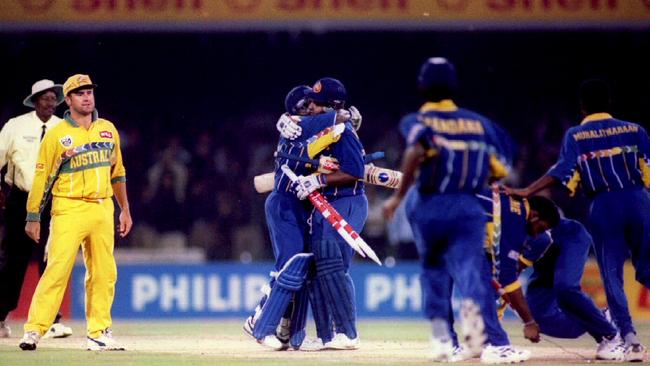
This year you’ll almost certainly be witness to some extraordinary slogging, especially in the early overs.
Records will tumble. Boundaries will be peppered. Bowlers will finish games in tears.
Let’s rewind and remind ourselves how we got to this point. How we landed in an era where scores of 300 are routine, and the 500 barrier is well and truly in sight.
And the answer is exactly why the 1996 World Cup was so special. It was a game changer. It was Sanath Jayasuriya defying convention, attacking from ball one, taking advantage of newly introduced fielding restrictions and the modern-day powerplays, and upsetting the status quo.
What seems obvious strategy now — chasing runs while fielding restrictions are in place — was truly revolutionary when Jayasuriya and Romesh Kaluwitharana unleashed with their blazing bats.
They changed the game. And this was the World Cup when it all crystallised.
Best innings: Gary Kirsten’s blazing 188 against the UAE was the highest World Cup score in history, a record he held until 2015, but Aravinda de Silva’s 107 from 124 in the final made a tricky chase a piece of cake and delivered a triumphant victory for Sri Lanka.
Best bowling: Shane Warne weaving his magic against the West Indies caused a remarkable turnaround and led to one of the great World Cup collapses, taking 4-36 — including three wickets as the West Indies dropped 7-37. Which leads us to ….
Best game: Australia’s get out-of-jail performance in the semi-final didn’t quite reach 1999 World Cup levels of ‘choke’, but it was a remarkable capitulation from the West Indies. Defending a modest total of 207, having recovered from being 4-15, Australia were again on the ropes big time. The West Indies were 3-165 when Shivnarine Chanderpaul made his way back to the sheds in the 42nd over — leaving 43 runs required. What followed was a collapse for the ages and when Courtney Walsh was bowled by Damien Fleming, Australia had triumphed by five runs and the Calypso Kings were left to lament a blown opportunity.
If this World Cup was a TV show it would be … THE SOPRANOS
This was the tournament that rewrote the script — and set the tone for how World Cups have been played ever since. Explosive drama.
—
No.2: 1975
The first ever Cricket World Cup was a step in to the unknown, with the opening fixture just the 19th ODI ever played. But with some familiar trappings. Players still wore whites and a red ball was used and for most teams the format was approached as something akin to a truncated Test match.
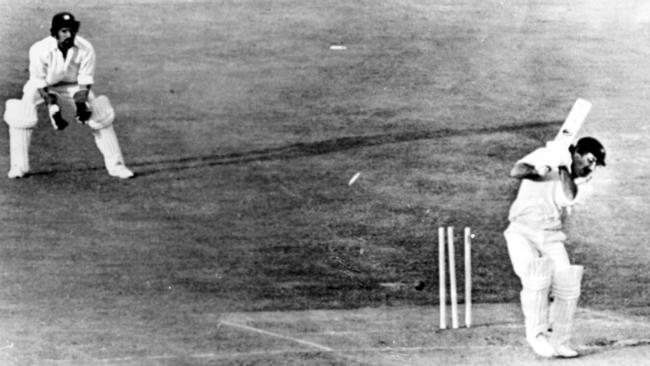
None more so than the Indians, especially in their opening fixture with England, where Sunil Gavaskar carried his bat in response to the hosts’ 4-334, scoring just 36 to effectively concede the match.
Despite that difficult birth, the event was an unmitigated success, in large part thanks to the brilliance of the then all-powerful West Indians.

England made the early running, however, seeing off New Zealand, India and a composite team representing East Africa, while the West Indies served notice with a seven-wicket win over a strong Australian unit containing Dennis Lillee, Jeff Thompson and Geoff Marsh in the other group.
Australia — in another familiar trope of World Cups to come — got the better of England on a bowlers paradise at Headingley in the first semi-final, while West Indies saw off New Zealand with almost 20 overs to spare at the Oval.
That set up a final to justify the whole exercise, in which the might of West Indies was too much for a battling Australia to contend with, despite putting up genuine and valiant resistance.
The World Cup project in 1975 was an experiment. Success on and off the pitch ensured it was here to stay.
Best innings: Alvin Kallicharran’s 78 against Australia in West Indies’ group win over Australia was a thing of brutal, provocative beauty. Few men have dared take on Lillee the way he did that day; even fewer have achieved anything close to that level of success.
Best bowling: The left-arm swing bowling of Australia’s Gary Gilmour was perfectly made for the seaming friendly deck at Headingley in Australia’s semi-final with England. His six wickets cost just 14 runs and was the principle wrecking ball that left England in rubble of 93 all out.
Best game: Fittingly it was the final itself which produced the most intense drama and quality to remember the event by. With the clock at Lord’s inching towards 9pm, a sea of West Indian fans swept across the pitch to celebrate a victory that had looked straightforward after Clive Lloyd found the boundary 14 times on route to a century, only for Thompson and Lillee to dig in from 9 for 233 chasing 292 to win to get within 18 runs.
If this World Cup was a TV show it would be … THE SIMPSONS
A great team flexing its muscles in a ground-breaking way — had this World Cup not been special, would the concept have taken off? Sadly for both the Simpsons and the West Indies, it’s been a pretty steady decline after the glory years.
—
No.1: 1999
World Cups don’t come any more dramatic than the 1999 edition — and Australia was at the centre of much of the madness.

The hot favourites’ tournament was on life support more times than they cared to count.
After losses to New Zealand and Pakistan in their opening three group games, Australia were on the verge of a shock early exit after their star-studded line-up (a literal who’s who of all-time greats with Warne, McGrath, Gilchrist, the Waughs, Ponting and Bevan all involved) before they managed to get things together.
There was the classic, and perhaps slightly embellished, “you just dropped the World Cup” sledge and the chaotic drawn semi-final.
Pakistan’s Saqlain Mushtaq became just the second bowler to take a World Cup hat-trick.
This was a World Cup that had it all.
And it also had Lance Klusener.
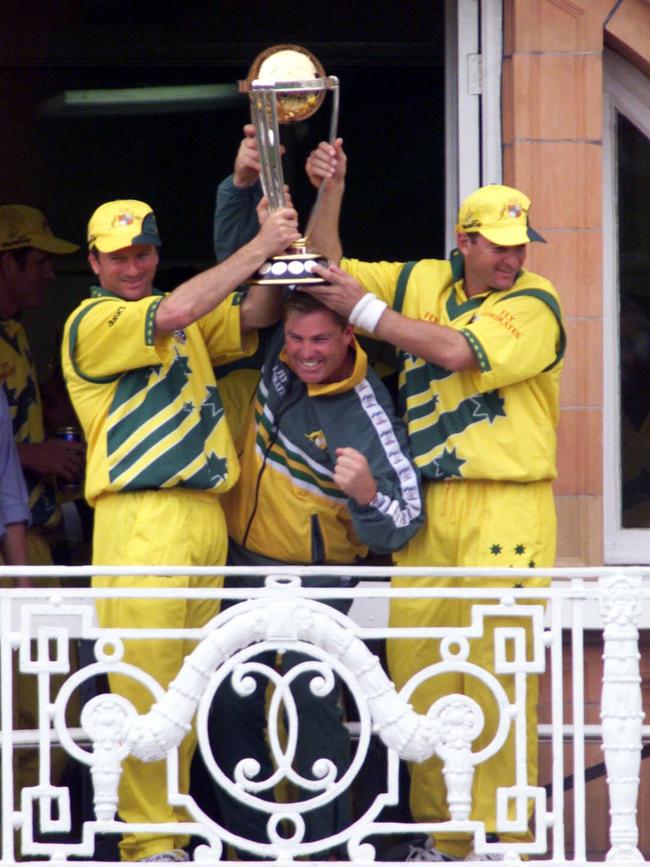
Really, this deserved to be Lance Klusener’s World Cup. The giant South African had a breakthrough tournament and looked to be set to take over world cricket with his fearsome batting and all-round ability.
Instead, despite finishing as the player of the tournament, it will forever remain an unfortunate stain on his career.
Because, of course, he was at the centre of the extraordinary run-out mix-up with Allan Donald which resulted in a remarkable draw … and ultimately cost his country a spot in the final.
It was a cruel end to a super tournament. And allowed Australia to notch their second title in relatively comfortable fashion over Pakistan in an underwhelming final.
Best innings: With Australia’s World Cup on the line, needing a victory to reach the semi-finals, Steve Waugh stroked an unbeaten 120 to steer Australia to the winning total of 5-275 with two balls to spare — thanks, in part, to a hurried-celebration-turned-dropped-catch from Herschelle Gibbs. You know the one. It cemented Waugh’s reputation as the ‘iceman’.
Best bowling: Glenn McGrath took 5-14 against a powerful West Indian batting outfit, knocking over Brian Lara, Jimmy Adams and Sherwin Campbell along the way. And Courtney Walsh terrified Scotland’s hapless batsmen, taking 3-7 in seven overs as the Scots were skittled for a paltry 68 (having at one point been 7-29). But neither were half as extraordinary as Shane Warne’s 4-29 which triggered South Africa’s staggering collapse — and the greatest choke of all.
Best game: Don’t overthink it. If the 1999 World Cup can be condensed into one game — or even one image — it is this one. Although a partial credit goes to Zimbabwe’s 48-run win over South Africa in the Super Sixes, given that prevented England from qualifying for the Super Sixes stage. Bravo.
If this World Cup was a TV show it would be … SEINFELD
A truly iconic World Cup, with South Africa’s various forms of self-sabotage the height of comedy for rival fans. The final/finale was a bit of a fizzer, though.
Originally published as Every Cricket World Cup ranked from worst to best


